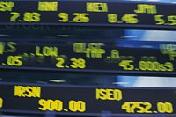
 |
|
| Financial Terms | |
| Eligible bankers' acceptances |
|
Information about financial, finance, business, accounting, payroll, inventory, investment, money, inventory control, stock trading, financial advisor, tax advisor, credit.
Main Page: stock trading, credit, accounting, investment, finance, financial, financial advisor, business, |
Definition of Eligible bankers' acceptances
Eligible bankers' acceptancesIn the BA market, an acceptance may be referred to as eligible because it is
Related Terms:Bankers AcceptancesA bill of exchange, or draft, drawn by the borrower for payment on a specified date, and accepted by a chartered bank. Upon acceptance, the bill becomes, in effect, a postdated certified cheque. ADF (annuity discount factor)the present value of a finite stream of cash flows for every beginning $1 of cash flow. DLOC (discount for lack of control)an amount or percentage deducted from a pro rata share of the value of 100% of an equity interest in a business, to reflect the absence of some or all of the powers of control. DLOM (discount for lack of marketability)an amount or percentage deducted from an equity interest to reflect lack of marketability. discount ratethe rate of return on investment that would be required by a prudent investor to invest in an asset with a specific level risk. Also, a rate of return used to convert a monetary sum, payable or receivable in the future, into present value. fractional interest discountthe combined discounts for lack of control and marketability. g the constant growth rate in cash flows or net income used in the ADF, Gordon model, or present value factor. QMDM (quantitative marketability discount model)model for calculating DLOM for minority interests r the discount rate  Abandonment optionThe option of terminating an investment earlier than originally planned. Accretion (of a discount)In portfolio accounting, a straight-line accumulation of capital gains on discount Adjustable rate preferred stock (ARPS)Publicly traded issues that may be collateralized by mortgages and MBSs. Agency bankA form of organization commonly used by foreign BAnks to enter the U.S. market. An agency Agency basisA means of compensating the broker of a program trade solely on the BAsis of commission American Stock Exchange (AMEX)The second-largest stock exchange in the United States. It trades Announcement datedate on which particular news concerning a given company is announced to the public. Antidilutive effectResult of a transaction that increases earnings per common share (e.g. by decreasing the Asset-backed securityA security that is collateralized by loans, leases, receivables, or installment contracts  Asset-based financingMethods of financing in which lenders and equity investors look principally to the Assets requirementsA common element of a financial plan that describes projected capital spending and the Auction marketsmarkets in which the prevailing price is determined through the free interaction of Auction rate preferred stock (ARPS)Floating rate preferred stock, the dividend on which is adjusted every Back feeThe fee paid on the extension date if the buyer wishes to continue the option. Back officeBrokerage house clerical operations that support, but do not include, the trading of stocks and Back-to-back financingAn intercompany loan channeled through a BAnk. Back-to-back loanA loan in which two companies in separate countries borrow each other's currency for a Back-up1) When bond yields and prices fall, the market is said to BAck-up. BackwardationA market condition in which futures prices are lower in the distant delivery months than in Baker PlanA plan by U.S. Treasury Secretary James BAker under which 15 principal middle-income debtor  Balance of paymentsA statistical compilation formulated by a sovereign nation of all economic transactions Balance of tradeNet flow of goods (exports minus imports) between countries. Balance sheetAlso called the statement of financial condition, it is a summary of the assets, liabilities, and Balance sheet exposureSee:accounting exposure. Balance sheet identityTotal Assets = Total Liabilities + Total Stockholders' Equity Balanced fundAn investment company that invests in stocks and bonds. The same as a BAlanced mutual fund. Balanced mutual fundThis is a fund that buys common stock, preferred stock and bonds. The same as a Balloon maturityAny large principal payment due at maturity for a bond or loan with or without a a sinking BAN (Bank anticipation notes)Notes issued by states and municipalities to obtain interim financing for BaneIn the words of Warren Buffet, bill BAne Sr., is, "a great American and one of the last real traders Bank collection floatThe time that elapses between when a check is deposited into a BAnk account and when the funds are available to the depositor, during which period the BAnk is collecting payment from the payer's BAnk. Bank discount basisA convention used for quoting bids and offers for treasury bills in terms of annualized Bank draftA draft addressed to a BAnk. Bank lineLine of credit granted by a BAnk to a customer. Bank wireA computer message system linking major BAnks. It is used not for effecting payments, but as a Banker's acceptanceA short-term credit investment created by a non-financial firm and guaranteed by a Bank for International Settlements (BIS)An international BAnk headquartered in BAsel, Switzerland, which BankruptcyState of being unable to pay debts. Thus, the ownership of the firm's assets is transferred from Bankruptcy cost viewThe argument that expected indirect and direct BAnkruptcy costs offset the other Bankruptcy riskThe risk that a firm will be unable to meet its debt obligations. Also referred to as default or insolvency risk. Bankruptcy viewThe argument that expected BAnkruptcy costs preclude firms from being financed entirely BarSlang for one million dollars. Barbell strategyA strategy in which the maturities of the securities included in the portfolio are concentrated Bargain-purchase-price optionGives the lessee the option to purchase the asset at a price below fair market BARRA's performance analysis (PERFAN)A method developed by BARRA, a consulting firm in Barrier optionsContracts with trigger points that, when crossed, automatically generate buying or selling of Base interest rateRelated: Benchmark interest rate. Base probability of lossThe proBAbility of not achieving a portfolio expected return. Basic balanceIn a BAlance of payments, the BAsic BAlance is the net BAlance of the combination of the current Basic business strategiesKey strategies a firm intends to pursue in carrying out its business plan. Basic IRR ruleAccept the project if IRR is greater than the discount rate; reject the project is lower than the BasisRegarding a futures contract, the difference between the cash price and the futures price observed in the Basis pointIn the bond market, the smallest measure used for quoting yields is a BAsis point. Each percentage Basis pricePrice expressed in terms of yield to maturity or annual rate of return. Basis riskThe uncertainty about the BAsis at the time a hedge may be lifted. Hedging substitutes BAsis risk for Basket optionsPackages that involve the exchange of more than two currencies against a BAse currency at Basket tradesRelated: Program trades. Bear marketAny market in which prices are in a declining trend. Big BangThe term applied to the liberalization in 1986 of the London Stock exchange in which trading was Bill of exchangeGeneral term for a document demanding payment. Bill of ladingA contract between the exporter and a transportation company in which the latter agrees to Black marketAn illegal market. Bond-equivalent basisThe method used for computing the bond-equivalent yield. Borrower falloutIn the mortgage pipeline, the risk that prospective borrowers of loans committed to be Break-even lease paymentThe lease payment at which a party to a prospective lease is indifferent between Break-even payment rateThe prepayment rate of a MBS coUpon that will produce the same CFY as that of Brokered marketA market where an intermediary offers search services to buyers and sellers. Bull marketAny market in which prices are in an upward trend. Bulldog marketThe foreign market in the United Kingdom. Buy-backAnother term for a repo. Calendar effectThe tendency of stocks to perform differently at different times, including such anomalies as Call dateA date before maturity, specified at issuance, when the issuer of a bond may retire part of the bond Capital marketThe market for trading long-term debt instruments (those that mature in more than one year). Capital market efficiencyReflects the relative amount of wealth wasted in making transactions. An efficient Capital market imperfections viewThe view that issuing debt is generally valuable but that the firm's Capital market line (CML)The line defined by every combination of the risk-free asset and the market portfolio. Cash discountAn incentive offered to purchasers of a firm's product for payment within a specified time Cash management billVery short maturity bills that the Treasury occasionally sells because its cash Cash marketsAlso called spot markets, these are markets that involve the immediate delivery of a security Chicago Mercantile Exchange (CME)A not-for-profit corporation owned by its members. Its primary Clearing House Automated Payments System (CHAPS)A computerized clearing system for sterling funds Clearing House Interbank Payments System (CHIPS)An international wire transfer system for high-value Clientele effectThe grouping of investors who have a preference that the firm follow a particular financing Coinsurance effectRefers to the fact that the merger of two firms decreases the proBAbility of default on CollateralAssets than can be repossessed if a borrower defaults. Collateral trust bondsA bond in which the issuer (often a holding company) grants investors a lien on Collateralized mortgage obligation (CMO)A security BAcked by a pool of pass-throughs , structured so that Commercial draftDemand for payment. Commodities Exchange Center (CEC)The location of five New York futures exchanges: Commodity Common marketAn agreement between two or more countries that permits the free movement of capital Common stock marketThe market for trading equities, not including preferred stock. Common-base-year analysisThe representing of accounting information over multiple years as percentages Compensating balanceAn excess BAlance that is left in a BAnk to provide indirect compensation for loans Complete capital marketA market in which there is a distinct marketable security for each and every Related to : financial, finance, business, accounting, payroll, inventory, investment, money, inventory control, stock trading, financial advisor, tax advisor, credit. |